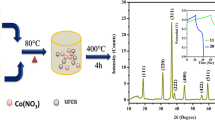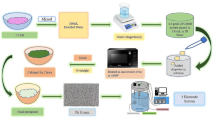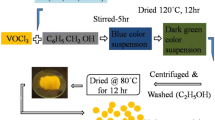Abstract
The electrochemical performance of highly crystalline cobalt oxide (Co3O4) nanoparticles is described in this work using an oxalate-assisted hydrothermal synthesis in the presence of a natural surfactant. The Co3O4 nanoparticle has a cubic spinel crystal structure with a crystallite size of 39 nm as determined XRD analysis. FTIR and UV–vis spectrum methods are used to evaluate the optical and functional properties of the synthesized Co3O4 nanoparticles. Due to the quantum confinement effect, the UV–vis spectrum of Co3O4 nanoparticles shows a wide energy band gap of 4.78 eV, which confirms the semiconducting nature of Co3O4 nanoparticles. The excellent performance is attributable to the simple accessibility of the electrolyte as well as the porous poly-pyramidal shape, which enables Co3O4 nanoparticles’ volume expansion. In light of their charging and discharging behaviour, electrochemical examination of green chemical oxalate aided Co3O4 nanoparticles reveals remarkable super capacitance behaviour with rapid dissemination of electrolyte ions on the electrode. These findings discover that the hydrothermally synthesized Co3O4 nanoparticles are novel materials for making high-potential super capacitors.










Similar content being viewed by others
Data Availability
All the data were confidential.
References
R. Shi, G. Chen, W. Ma, D. Zhang, G. Qiu, X. Liu, Shape-controlled synthesis and characterization of cobalt oxides hollow spheres and octahedra. Dalton Trans. 41(19), 5981–5987 (2012)
Y. Ni, X. Ge, Z. Zhang, H. Liu, Z. Zhu, Qiang Ye, A simple reduction- oxidation route to prepare Co3O4 nanocrystals. Mater. Res. Bull. 36, 2383–2387 (2001)
S. Mohan, M. Vellakkat, A. Aravind, U. Reka, Hydrothermal synthesis and characterization of zinc oxide nanoparticles of various shapes under different reaction conditions. Nano Express 1(3), 030028 (2020)
S. Tanwar, D. Mathur, Hydrothermal synthesis and characterization of zinc oxide nanoplates. Materials Today: Proceedings 47, 4647–4651 (2021)
C. Priyadharsini, P. Anbarasan, V. Aroulmoji, V. Siva. Synthesize, characterization and electrochemical investigations of cobalt oxide nanoparticles to supercapacitor application. Aegaeum Journal. (2020)
S. Farhadi, J. Safabakhsh, P. Zaringhadam, Synthesis, characterization, and investigation of optical and magnetic properties of cobalt oxide (Co3O4) nanoparticles. J. Nanostructure Chem. 3(1), 1–9 (2013)
M.T. Makhlouf, B.M. Abu-Zied, T.H. Mansoure, Nanocrystalline Co3O4 fabricated via the combustion method. Met. Mater. Int. 19(3), 489–495 (2013)
G. Wang, X. Shen, J. Horvat, B. Wang, H. Liu, D. Wexler, J. Yao, Hydrothermal synthesis and optical, magnetic, and supercapacitance properties of nanoporous cobalt oxide nanorods. J. Phys. Chem. C 113(11), 4357–4361 (2009)
H. Hayashi, Y. Hakuta, Hydrothermal synthesis of metal oxide nanoparticles in supercritical water. Materials 3(7), 3794–3817 (2010)
G. Durai, P. Kuppusami, T. Maiyalagan, M. Ahila, Supercapacitive properties of manganese nitride thin film electrodes prepared by reactive magnetron sputtering: effect of different electrolytes. Ceram. Int. 45(14), 17120–17127 (2019)
S. Vijayakumar, A.K. Ponnalagi, S. Nagamuthu, G. Muralidharan, Microwave assisted synthesis of Co3O4 nanoparticles for high-performance supercapacitors. Electrochim. Acta 106, 500–505 (2013)
M.Y. Nassar, I.S. Ahmed, Hydrothermal synthesis of cobalt carbonates using different counter ions: an efficient precursor to nano-sized cobalt oxide (Co3O4). Polyhedron 30(15), 2431–2437 (2011)
Y. Liang, Y. Yang, Z. Hu, Y. Zhang, Z. Li, N. An, H. Wu, Three-dimensional cage-like Co3O4 structure constructed by nanowires for supercapacitor. Int. J. Electrochem. Sci. 11, 4092–4109 (2016)
X. Wang, X. Chen, L. Gao, H. Zheng, Z. Zhang, Y. Qian, One-dimensional arrays of Co3O4 nanoparticles: synthesis, characterization, and optical and electrochemical properties. J. Phys. Chem. B 108(42), 16401–16404 (2004)
R. Heimböckel, F. Hoffmann, M. Fröba, Insights into the influence of the pore size and surface area of activated carbons on the energy storage of electric double layer capacitors with a new potentially universally applicable capacitor model. Phys. Chem. Chem. Phys. 21(6), 3122–3133 (2019)
Z. Seidov, M. Açıkgöz, S. Kazan, F. Mikailzade, Magnetic properties of Co3O4 polycrystal powder. Ceram. Int. 42(11), 12928–12931 (2016)
I.A.Z. Al-Ogaidi, Camellia sinensis (green tea) mediated synthesis of zinc oxide nanoparticles and detect its antibacterial activity against Escherichia coli, Staphylococcus aureus and Acinetobacter baumannii. Journal of Biotechnology Research Center 11(1), 34–40 (2017)
M. Sivachidambaram, J.J. Vijaya, K. Kaviyarasu, L.J. Kennedy, H.A. Al-Lohedan, R.J. Ramalingam, A novel synthesis protocol for Co3O4 nanocatalysts and their catalytic applications. RSC Adv. 7(62), 38861–38870 (2017)
M. Silambarasan, P.S. Ramesh, D. Geetha, Facile one-step synthesis, structural, optical and electrochemical properties of NiCo2O4 nanostructures. J. Mater. Sci.: Mater. Electron. 28(1), 323–336 (2017)
V.S. Kumbhar, Y.R. Lee, C.S. Ra, D. Tuma, B.K. Min, J.J. Shim, Modified chemical synthesis of MnS nanoclusters on nickel foam for high performance all-solid-state asymmetric supercapacitors. RSC Adv. 7(27), 16348–16359 (2017)
G. Bhattacharya, G. Kandasamy, N. Soin, R.K. Upadhyay, S. Deshmukh, Maity, & Roy, S. S., Novel π-conjugated iron oxide/reduced graphene oxide nanocomposites for high performance electrochemical supercapacitors. RSC Adv. 7(1), 327–335 (2017)
H. Yang et al., Graphene supercapacitor with both high power and energy density. Nanotechnology 28(44), 445401 (2017)
S.G. Kandalkar et al., Chemical synthesis of cobalt oxide thin film electrode for supercapacitor application. Synth. Met. 160(11–12), 1299–1302 (2010)
M.K. Lima-Tenório, C.S. Ferreira, Q.H.F. Rebelo, R.F.B.D. Souza, R.R. Passos, E.A.G. Pineda, L.A. Pocrifka, Pseudocapacitance properties of Co3O4 nanoparticles synthesized using a modified sol-gel method. Mater. Res. 21 (2018)
J.L. Li, F. Gao, Y. Jing, R.Y. Miao, K.Z. Wu, X.D. Wang, Electrochemical characterization of MnO2 as the cathode material for a high voltage hybrid capacitor. Int. J. Miner. Metall. Mater. 16(5), 576–580 (2009)
Y. Xie, F. Tian, Capacitive performance of molybdenum nitride/ titanium nitride nanotube array for supercapacitor. Mater. Sci. Eng. 215, 64–70 (2017)
R. Lucio-Porto et al., VN thin films as electrode materials for electrochemical capacitors. Electrochim. Acta 141, 203–211 (2014)
C.T. Anuradha, P. Raji, Facile synthesis and characterization of Co3O4 nanoparticles for high-performance supercapacitors using Camellia sinensis. Appl. Phys. A 126(3), 1–12 (2020)
Acknowledgements
The authors gratefully acknowledge Thiru. A. Tenzing, correspondent, Dr. S. Arivazhagan, principal, and Dr. A. Marikani, head, Department of Physics, Mepco Schlenk Engineering College, Sivakasi, for their support and encouragement to carry out this research work.
Author information
Authors and Affiliations
Contributions
Mrs.C.T. Anuradha: Conceptualization, methodology, investigation, interpretation, writing. Dr.P. Raji: Reviewing and editing.
Corresponding author
Ethics declarations
Conflict of Interest
The author declares no competing interest.
Additional information
Publisher's Note
Springer Nature remains neutral with regard to jurisdictional claims in published maps and institutional affiliations.
Rights and permissions
Springer Nature or its licensor (e.g. a society or other partner) holds exclusive rights to this article under a publishing agreement with the author(s) or other rightsholder(s); author self-archiving of the accepted manuscript version of this article is solely governed by the terms of such publishing agreement and applicable law.
About this article
Cite this article
Anuradha, C.T., Raji, P. Hydrothermal Synthesis, Characterization, and Electrochemical Behaviour of Cobalt Oxide (Co3O4) Nanoparticles for Stable Electrode with Enhanced Supercapacitance. Braz J Phys 52, 211 (2022). https://doi.org/10.1007/s13538-022-01214-4
Received:
Accepted:
Published:
DOI: https://doi.org/10.1007/s13538-022-01214-4




